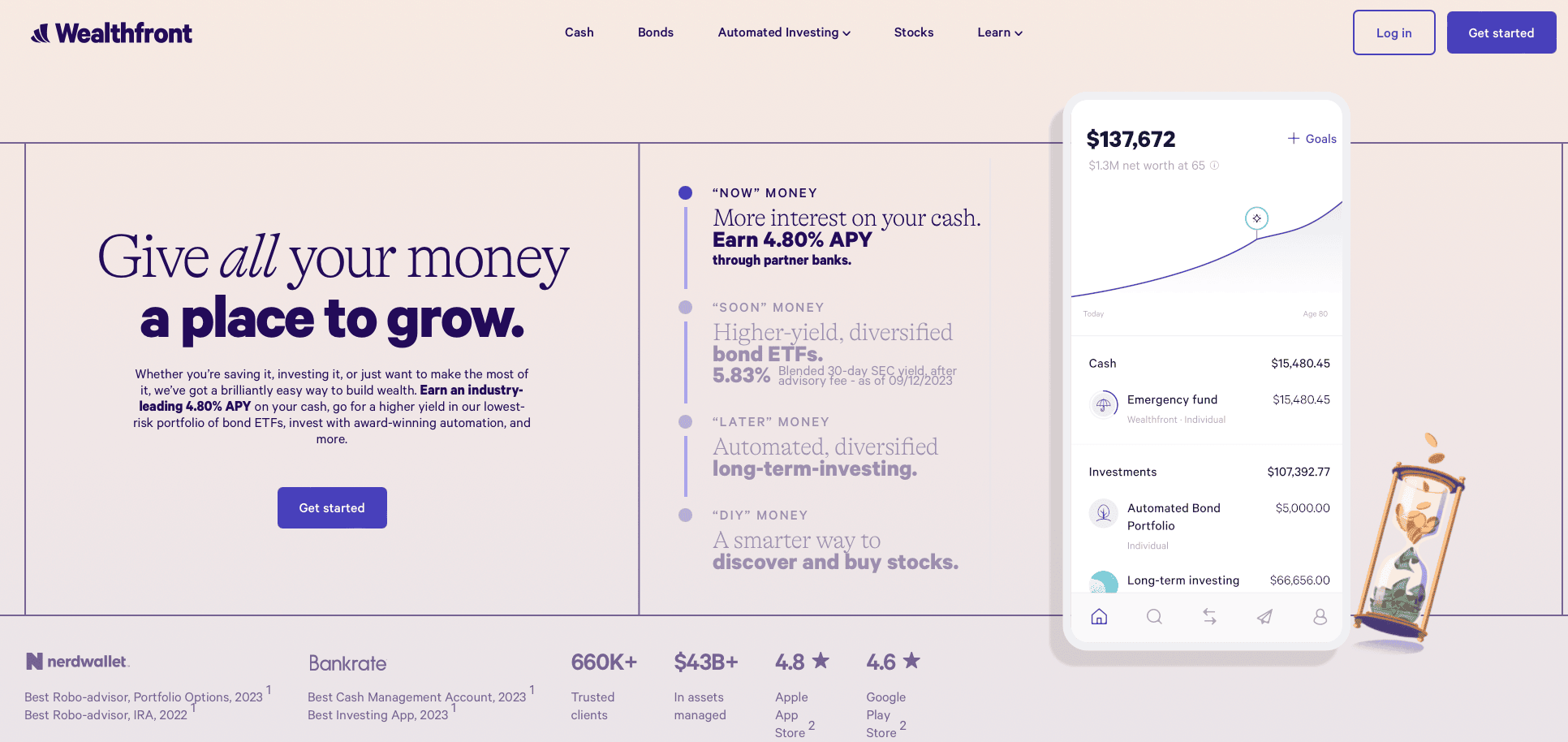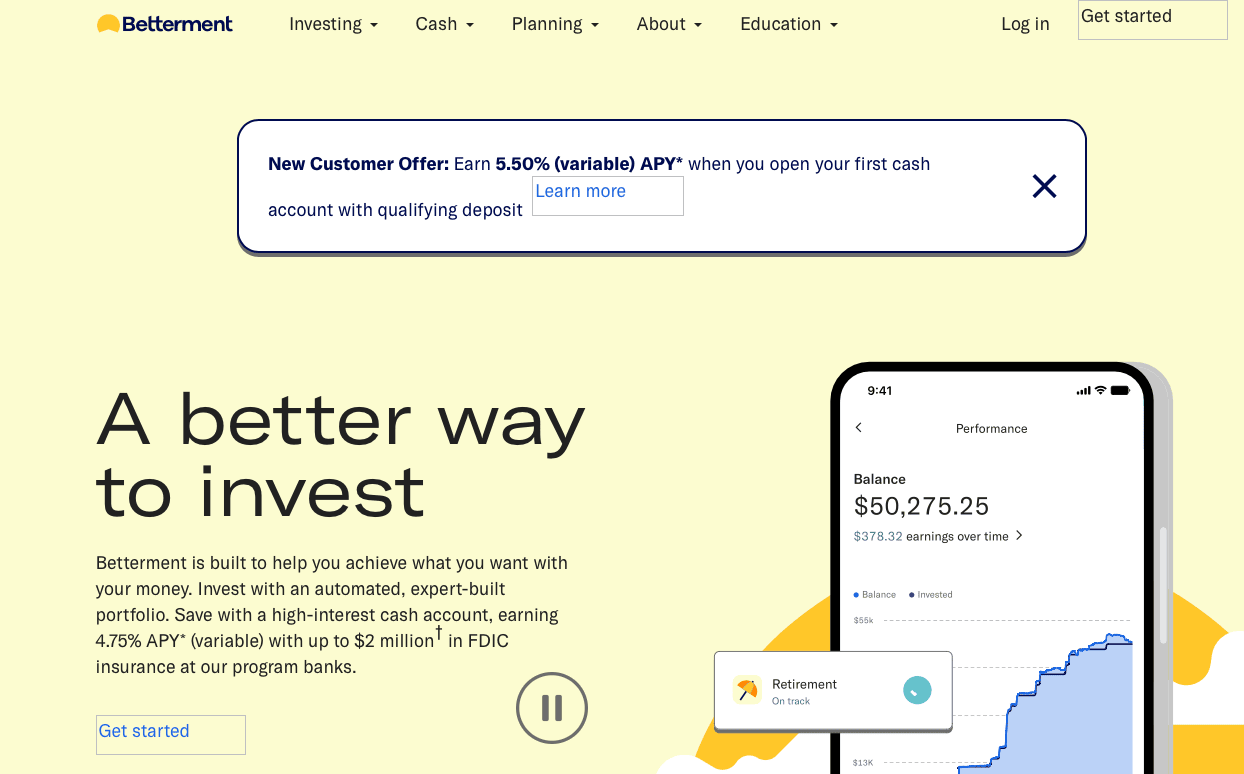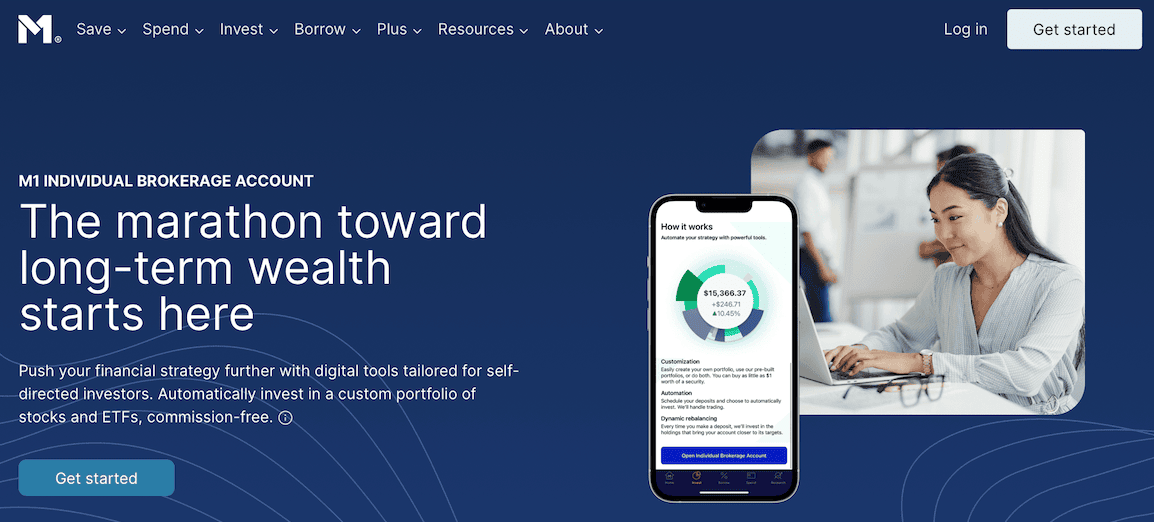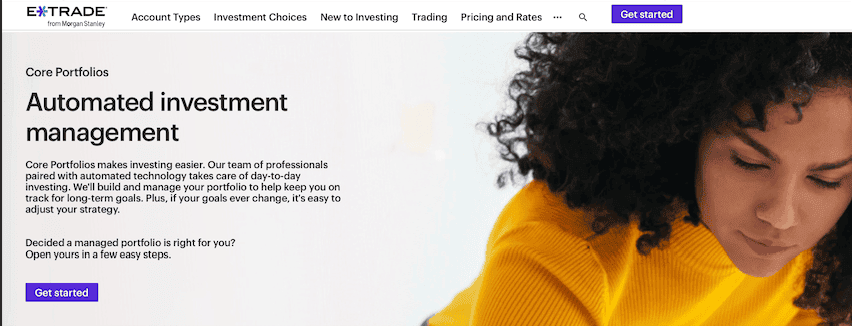What you'll learn:
➤ What’s a Robo Advisor?
Robo-advisors, also known as digital investment managers, offer a convenient solution for investors seeking automated investment services.
These platforms, such as Betterment, Wealthfront, and Empower (formerly Personal Capital), emerged in the wake of the 2008 financial crisis.
In response to their success, numerous new robo-advisor companies entered the market, aiming to provide comprehensive financial planning services at a reduced management fee compared to traditional financial planners.
| Best Robo Advisors | Account Minimum: | Fees: | Best for: |
|---|---|---|---|
| Wealthfront | $500 | 0.25% for most accounts 0.42%-0.46% for 529 plans | Overall |
| Betterment | $0 ($10 to start investing) | 0.25% for accounts with at least $20k or at least $250 per month in recurring account deposit or $4/month | Beginners |
| Merrill Edge Guided Investing | $1,000 | 0.45% of assets under management 0.85% with advisor | Education |
| M1 Finance | $100 ($500 minimum for retirement accounts) | 0% | Sophisticated Investors |
| E*TRADE | $500 | 0.30% | Mobile |
1️⃣ Wealthfront (Best Overall)
- Account Minimum: $500
- Fees: 0.25% for most accounts, no trading commission or fees for withdrawals, minimums, or transfers

Why Wealthfront?
1. Best Overall
Wealthfront offers a comprehensive investment and money management solution suitable for all types of investors.
With its low fees and accessible minimum investment requirement, customizable automated portfolios, options for stock investing, high-yield cash accounts, exceptional digital financial planning tools, and lending capabilities, Wealthfront undoubtedly deserves recognition as the best overall robo-advisor.
2. Best for Portfolio Management
Wealthfront allows clients and users to link their investment accounts or manually input them, providing a holistic view and in-depth analysis of their financial situation. The Path digital financial planner is designed to address up to 10,000 queries, making it the closest online tool to having a human financial planner by your side.
3. Best for Goal Planning
Wealthfront users can seamlessly integrate their robo-advisor accounts with external accounts through Path, enabling advanced goal planning. Path’s embedded calculators assist with retirement, homeownership, college planning, and managing finances during career breaks.
4. Best for Portfolio Construction
Wealthfront constructs portfolios based on well-established investment management principles like Modern Portfolio Theory (MPT) by Harry Markowitz. These portfolios encompass 17 asset classes, including stocks, bonds, and inflation assets, resulting in some of the most meticulously crafted portfolios in the robo-advisory sector.
Pros & Cons of Wealthfront
Pros:
- Exceptional Core and ESG portfolios with extensive customization options
- Diverse account types, including 529 plans for college savings
- Direct indexing for accounts exceeding $100,000
- Top-tier Path digital financial planner
Cons:
- No access to human financial advisors
- Lack of online chat support
- Phone access may not be straightforward
About Wealthfront
In 2008, tech entrepreneurs Dan Carroll and Andy Rachleff embarked on a mission to democratize research-based investment strategies and make them accessible to the public. With an impressive $274.8 million in external funding from 39 investors, Wealthfront has become a frontrunner in the robo-advisor industry.
From its roots as a basic algorithm-driven digital investment manager, the company has expanded to include a wide range of ETFs, supplementing its Core and ESG robo-advisory portfolios. Users can even create their own ETF portfolios for Wealthfront to manage.
With the recent addition of an automated bond portfolio and fee-free stock trading, Wealthfront caters to the financial needs of most investors.
At the heart of Wealthfront’s offerings are its automated investment portfolios. By answering a few questions, users receive a personalized portfolio spanning 17 asset classes, tailored to their goals, time horizon, and risk tolerance. From this risk-adjusted portfolio, users can explore options with varying risk profiles, allowing for customization based on their preferences.
The portfolios are routinely rebalanced to maintain the desired asset mix, while tax-loss harvesting ensures taxable accounts remain tax-efficient. With a vast selection of ETFs, including sustainable, tech, value, growth, and crypto funds, users have the flexibility to tailor their investments to their preferences.
Additional Wealthfront features include:
- Fee-free high-yield cash accounts and debit cards
- An automated bond portfolio for consistent cash flow
- Fee-free stock investing, featuring over 35 themed stock collections and research
- A variety of account types for investing, retirement, trusts, and 529 college planning
- Low-interest rate borrowing options
- The remarkable Path digital financial advisor, equipped to answer over 10,000 inquiries
- Daily tax-loss harvesting
Trust Wealthfront to help you navigate the path to financial success with its array of cutting-edge financial tools and services.
2️⃣ Betterment (Best for Beginners)
- Account Minimum: $0, with a $10 minimum to commence investing
- Fees:
- 0.25% (annual) for investing plan accounts with a minimum of $20,000 or a recurring deposit of at least $250 per month.
- For other accounts, the fee is $4 per month.
- An additional 0.15% (annual) fee applies to accounts with a minimum of $100,000, providing account holders with unlimited access to certified financial planners, along with a 1% crypto fee. This additional fee is applicable to assets in investment and cryptocurrency accounts, excluding cash accounts.
- A fee discount of 0.10% is available for accounts with at least $2 million.
- Crypto accounts are charged a monthly fee of 1% plus trading expenses.

Why Betterment?
1. Best for Beginners
Betterment welcomes novice investors with open arms, allowing them to initiate their investment journey on its user-friendly platform with as little as $10. The platform boasts a wide array of portfolio options, including crypto investments, providing ample choices for investors.
2. Best for Cash Management
What sets Betterment apart is its automatic sweep functionality, which grants access to both a high-yield cash reserve and a checking account through partner banks. The platform also stands out by reimbursing ATM fees—a valuable perk for account holders.
Pros & Cons of Betterment
Pros:
- Easy setup and tracking of multiple financial goals
- Diverse portfolio options, including smart beta, SRI, income, and crypto
- $0 account minimum and a low $10 minimum investment requirement
- Affordable financial advice packages for digital customers
Cons:
- No borrowing or margin capabilities
- Premium plan requires a $100,000 minimum
- No exposure to Real Estate Investment Trusts (REITs)
About Betterment
Established in 2008 by Eli Broverman and Jon Stein in the bustling city of New York, Betterment has evolved into one of the most prominent standalone robo-advisors.
With a substantial $35 million in funding from 26 investors, Betterment stands as the top choice for beginners and those seeking efficient cash management solutions. Notably, the acquisition of Makara in 2022 has enabled Betterment to venture into the cryptocurrency investment arena.
Betterment’s user-friendly platform makes it particularly appealing to beginners. Users are guided through a brief questionnaire that helps clarify their investment objectives, time horizon, and risk tolerance. Based on their responses, users are presented with a tailored portfolio of investments that align with their financial goals.
The portfolio choices at Betterment encompass a wide spectrum:
- Core: Designed for long-term investment with a focus on global stocks and bonds.
- Innovative Technology: Concentrates on high-growth tech companies, including clean energy, semiconductors, and robotics.
- Climate Impact: Invests in companies with lower carbon emissions while still aiming for solid long-term returns.
- Universe: Delves into the crypto landscape, covering decentralized finances and the metaverse.
- Social Impact: Prioritizes companies dedicated to minority empowerment and gender diversity.
- Goldman Sachs Smart Beta: Aims to outperform the market by increasing risk levels.
- Sustainable: Seeks crypto assets that prioritize energy efficiency in transaction validation.
- Broad Impact: Focuses on companies that excel in environmental, social, and governance (ESG) criteria while balancing this filter with long-term performance.
Betterment offers typical robo-advisory portfolio management features, including regular rebalancing and tax-loss harvesting. For account holders with $100,000 or more, the Premium plan is available at a 0.40% management fee, granting access to unlimited video sessions with Certified Financial Planners.
One of Betterment’s standout features is its fee-free cash management, offering high-yield cash and checking accounts through partner banks. These accounts boast $2 million in FDIC insurance, unlimited withdrawals, and no minimum balance requirements.
The checking account and Visa debit card come with $250,000 FDIC insurance, as well as ATM fee and foreign transaction fee reimbursement.
It’s important to note that Cash Reserve is exclusively available to Betterment LLC clients, and cash transfers to program banks are conducted through clients’ brokerage accounts at Betterment Securities.
Neither Betterment Financial LLC nor any of its affiliates operate as a bank. Betterment Financial LLC reimburses ATM fees and the Visa 1% foreign transaction fee worldwide, wherever Visa is accepted.
3️⃣ Merrill Edge Guided Investing (Best for Education)
- Account Minimum: $1,000, or $20,000 with an advisor
- Fee:
- Annual fee of 0.45% based on assets under management, assessed monthly.
- With an advisor, the fee is 0.85%.
- Discounts are available for Bank of America Preferred Rewards participants.

Why Merrill Guided Investing?
Best for Education
Merrill Guided Investing leverages the resources and reputation of Merrill Lynch and Bank of America, offering a wealth of financial education that caters to beginners and advanced investors alike. This platform seamlessly combines its robust educational offerings with a solid robo-advisory service.
Pros & Cons of Merrill Guided Investing
Pros:
- 24/7 customer service
- Extensive educational resources, calculators, and tools suitable for a diverse range of investors
- Integration with Bank of America and Merrill Edge products, creating a comprehensive financial portal
- An abundance of educational tools, including webinars, videos, and courses
Cons:
- Fees are relatively higher compared to some competitors
- Lack of tax-loss harvesting feature
- No access to a financial advisor for online-only users
About Merrill Guided Investing
When you sign up for Merrill Guided Investing, you’re entering into a partnership with a division of Bank of America that carries the legacy of Merrill Lynch & Co., founded in 1914 by Charles E. Merrill.
This iconic company became part of Bank of America in 2009, as reported by Reuters. While it once exclusively catered to affluent Americans and engaged in investment banking activities, the company now seeks to serve a broader clientele.
Merrill Guided Investing capitalizes on the wealth of investment management expertise and educational resources available within the company. This robo-advisor distinguishes itself by blending technology-based investment management with oversight from Merrill investment professionals, led by the company’s Chief Investment Office.
The investment portfolios offered are designed to align with your specific goals, time horizon, and risk tolerance. They also provide access to sustainable Environmental, Social, and Governance (ESG) offerings.
Unlike standard passively managed robo-advisory services, Merrill’s portfolios are constructed and managed using strategic and tactical asset allocations. These allocations are tailored to each user’s unique goals, risk tolerance, financial situation, timeline, expected returns, and prevailing market conditions.
Merrill Guided Investing shines in its educational offerings, which encompass a range of valuable resources. These include webinars, the Morningstar Investing Classroom, and informative investor education videos.
Webinar categories cover diverse topics such as Investor Psychology, Thematic Investing with ETFs, and Sustainable Investing. The partnership with Morningstar provides access to numerous free courses on various investment topics, including stocks, funds, bonds, ETFs, and portfolio creation.
In addition to webinars and courses, Merrill offers a collection of informative videos that span platform-specific guidance and investment-related subjects. The Learn Portal further enhances the educational experience by providing practical tools and calculators for retirement planning, investing, college planning, and personal finance.
4️⃣ M1 Finance (Best for Sophisticated Investors)
- Account Minimum: $100 ($500 minimum for retirement accounts)
- Fee: 0%; $95 per year for M1 Plus (with 3-month promotion)

Why M1 Finance?
Best for Sophisticated Investors
M1 Finance is a unique investment platform tailored for strategic investors seeking access to expert theme-focused strategy portfolios. It also empowers users to handpick their own stocks and ETFs. With high-yield cash accounts and borrowing options, M1 Finance stands out as the top choice for sophisticated investors.
Best for Socially Responsible Investing
M1 Finance provides two outstanding and diversified sustainable Socially Responsible Investing (SRI) portfolios. The International Responsible Investing Portfolio encompasses both U.S. and international socially responsible equity funds.
Meanwhile, the Responsible Investing Portfolio comprises five U.S. sustainable equity funds. Self-directed investors can explore additional socially responsible ETFs.
Best for Low Costs
M1 Finance offers fee-free investing for customized expert-designed portfolios and self-directed stock and fund investors. This cost-effective approach ensures that more of your invested dollars are actively working for you. For enhanced features, you can opt for M1 Plus, available at $95 per year.
Pros & Cons of M1 Finance:
Pros:
- Opportunity to invest in 60+ customized Expert Pies or portfolios
- Access to thousands of ETFs and stocks for self-directed investors
- Fee-free investment option
- High-yield cash account
- Low-interest rate margin is available
Cons:
- Absence of a goals or risk tolerance quiz
- The platform requires a certain level of investment knowledge
- No access to financial advisors
- Lack of tax-loss harvesting feature
About M1 Finance
Founded by Brian Barnes in 2015, M1 Finance has garnered a remarkable $323.2 million in external funding from eight investors. What sets M1 Finance apart from the typical robo-advisory landscape is its commitment to granting users substantial discretion over their portfolio choices.
While M1 shares similarities with other automated investment platforms in terms of portfolio rebalancing, it excels in flexibility.
M1 offers pre-constructed, expertly designed portfolios, aptly named “Pies,” and self-directed stock and ETF assets that can be seamlessly rebalanced according to your preferred asset allocation.
The M1 Expert Pies encompass seven to ten funds each and revolve around distinct investment themes, including:
- General Investing: Resembling a typical robo-advisory portfolio, it comprises seven diversified risk-adjusted stock and bond ETF portfolios, ranging from ultra-conservative to ultra-aggressive.
- Plan for Retirement: Similar to a target date fund, this category features ten risk-adjusted stock/bond ETF portfolios tailored for investors anticipating retirement between 2020 and 2035.
- Responsible Investing: Offering two socially responsible Pies, one combining U.S. and international ESG ETFs, and the other dedicated solely to U.S. funds.
- Income Earners: This category includes six Pies with dividend yields between 2.012% and 3.69%, featuring portfolios comprising stock and/or bond ETFs.
- Hedge Fund Followers: Consisting of eight Pies that mirror the investment strategies of prominent hedge fund managers like Icahn Capital, Tiger Global Management, and Berkshire Hathaway.
- Just Stocks and Bonds: Incorporates nine Pies, each housing two Vanguard ETFs, an All-World Stock ETF, and a Total Bond ETF. These Pies offer varying asset allocations, catering to the most aggressive investors (ranging from 10% bonds and 90% stocks to 90% stocks and 10% bonds).
- Other Strategies: Encompasses seven Pies, featuring themes like value, growth, cannabis, and an Ark Innovation ETF portfolio.
For self-directed investors, M1 Finance provides access to thousands of ETFs and stocks, including three cryptocurrencies—Bitcoin, Ethereum, and Litecoin. Additional features include high-yield cash offers and M1 Borrow lending services, further enhancing your financial capabilities.
5️⃣ E*TRADE Core Portfolios (Best for Mobile)
- Account Minimum: $500
- Fee: 0.3%

Why E*TRADE Core Portfolios?
Best for Mobile Experience – 4.1 Rating
E*TRADE Core Portfolios, a proud member of the renowned Morgan Stanley family of investment products, offers a robust robo-advisor platform complemented by a user-friendly mobile app. This means you can access all the platform’s offerings right from the palm of your hand.
Pros & Cons of E*TRADE Core Portfolios
Pros:
- Diverse investment strategies, including core, ESG, smart beta, and income
- Mobile app functionality mirrors the desktop version, facilitating account opening and transfers
- Access to the extensive Morgan Stanley lineup of investment and financial management services
Cons:
- Competitive robo-advisors with lower costs are available
- No chat support
- Relatively limited goal-setting options in the portfolio creation process
About E*TRADE Core Portfolios
In October 2020, Morgan Stanley acquired the ETRADE company, broadening the scope of investment services available to self-directed investors seeking financial planning or robo-advisory guidance.
Like most robo-advisors, the ETRADE Core Portfolios initiates its investment process with a questionnaire. This assessment gauges your objectives, encompassing goals, liquidity requirements, time horizon, and risk tolerance. Based on your responses, a core investment portfolio tailored to your criteria is presented to you.
The investment portfolio choices comprise:
- Core
- Socially responsible
- Smart beta
- Income
ETRADE’s mobile app seamlessly integrates most features from the Core Portfolios desktop version, ensuring user-friendly navigation. You can conveniently open an account using the app and effortlessly transfer funds in and out of Core Portfolios. Moreover, ETRADE’s integration extends to checking, bill payments, and cash management. You can effortlessly switch between your Core Portfolios and self-directed trading account.
Additional Features:
- Phone support is available from a team of Core Portfolios specialists, accessible Monday through Friday.
- Portfolio selections are curated by the experienced E*TRADE Capital Management team.
- Tax-optimized portfolios are an option for those with taxable accounts.
- The E*TRADE Morgan Stanley platform offers comprehensive financial and life planning guidance. Topics covered include education, family finances, retirement, elder care, budgeting, and women and money.
➤ Best Robo Advisors FAQ
How to choose the best robo-advisor: When it comes to choosing the best robo-advisor, it’s crucial to align your selection with your unique financial situation and goals. The initial step in this process is gaining a clear understanding of your investment objectives.
While human advisors have historically helped individuals identify their financial goals, robo-advisors can guide you through the process using prompts and tools. However, the accuracy of a robo-advisor’s understanding of your financial situation primarily depends on the information you provide.
Investment goals can vary widely among investors, including buying a house, saving for retirement, funding education, and more. Depending on your age, certain goals may take precedence over others. To make the most of a robo-advisor, it’s essential to define your goals as precisely as possible.
For example, if you’re in your 20s, you might have goals like buying a house and saving for retirement. Retirement, being a long-term goal, allows for a more aggressive investment approach. Conversely, saving for a house, a shorter-term goal, prioritizes capital preservation and risk mitigation.
Having clear timelines and target dollar amounts allows robo-advisors to recommend portfolios with suitable risk-return profiles. The best robo-advisors offer tools to explore various scenarios, such as increasing contributions or dealing with market fluctuations, helping you make informed decisions to enhance your chances of success.
How to compare robo-advisors: While many investors share common expectations from robo-advisors, like user-friendly account setup, robust goal planning, portfolio management, security, responsive customer service, educational resources, and low fees, choosing the best robo-advisor ultimately depends on your specific financial circumstances.
For younger individuals with single financial goals like retirement or buying a home, most robo-advisors can be suitable. Younger investors may prioritize robo-advisors with low account minimums, basic capabilities, and low fees. It’s essential to distinguish between different fee tiers some robo-advisors offer, as higher tiers may provide additional features that you might not need.
As life and finances become more complex, having the ability to set multiple goals with different timelines becomes increasingly important. As your net worth grows, you might be willing to pay slightly higher fees for a robo-advisor that can handle multiple financial goals, offer cash management, and provide ongoing tax optimization.
The requirements for a robo-advisor change as investors age, with considerations like cash management and withdrawal planning becoming more critical for those closer to retirement.
Robo-advisors don’t primarily differentiate themselves based on portfolio performance, as they aim to mimic market returns with optimal diversification. Instead, the focus should be on the features and their quality. The robo-advisor space is continually evolving, ensuring investors with even complex financial needs have several options to choose from.
Robo-Advisors or Financial Advisors? When deciding between a robo-advisor and a human financial advisor, investors should weigh their priorities. Robo-advisors excel in providing portfolios based on modern portfolio theory (MPT) and goal-planning support at a low management fee. In contrast, human financial advisors emphasize building relationships and offer a broader range of services beyond portfolio management, including tax planning, budgeting, insurance, and estate planning.
Financial advisors have more flexibility in constructing portfolios than robo-advisors, as they can consider a client’s specific financial situation. However, commission-based financial advisors may push products that generate commissions, while robo-advisors are fee-focused and prioritize portfolio fit. Robo-advisors excel in rules-based portfolio management and regular rebalancing, while financial advisors may have more variable performance.
Robo-Advisor Cash Management Accounts Explained: As interest rates rise, high-yield cash accounts have become more appealing. Many robo-advisors now offer fee-free high-yield cash accounts through partner banks, providing competitive returns and substantial FDIC insurance coverage.
- Wealthfront’s Cash Account offers three account types with a low minimum requirement and competitive interest rates.
- Titan Smart Cash dynamically seeks the best rates for your cash, considering tax implications.
- Betterment offers high-yield cash accounts with special promotions for new users, providing additional returns.
What’s a Robo-Advisor? A robo-advisor is an investment platform that automates trades based on your inputs and modern portfolio theory (MPT) algorithms. Robo-advisors aim to maximize returns within acceptable risk levels through diversification.
They differ in complexity, asset offerings, account minimums, and costs. Advanced robo-advisors can handle multiple portfolios for various goals and consider external accounts for optimization.
Benefits of using a robo-advisor: Robo-advisors offer benefits like lower fees, disciplined investing, portfolio customization, access to human financial advisors, cash management, margin lending, and high-yield cash accounts. They provide diversified portfolios tailored to your goals and risk tolerance.
Is it safe to invest with a robo-advisor? Robo-advisors prioritize security with bank-level protocols, two-factor authentication, and limited employee access to personal information. Cash accounts may be FDIC-insured, and investment accounts typically have SIPC insurance. However, investments in financial markets are subject to normal volatility and carry inherent risks.
How much money do I need? Robo-advisors have varying minimum investment requirements, typically ranging from $10 to $100,000. Some also offer unlimited access to human financial advisors. Starting with a low minimum and gradually increasing contributions is a smart approach to building long-term wealth.
Fees of robo-advisors: Robo-advisor fees are generally below 0.50% of assets under management, significantly lower than traditional financial advisors who often charge over 1%. Premium offerings may have slightly higher fees. In both cases, the advisor’s effectiveness relies on the accuracy of the information provided about your financial situation and needs.
Portfolio performance: Most robo-advisors aim to match market returns through diversified portfolios. While some robo-advisors offer funds designed to outperform the market, the primary focus should be on goal alignment and portfolio suitability rather than performance. Investing with a robo-advisor ensures consistent portfolio management and regular rebalancing.
➤ Final thoughts
Selecting the ideal robo-advisor to align with your individual goals, financial circumstances, and risk tolerance is contingent on several key factors.
When making this decision, it’s crucial to assess your specific requirements for customization, available account types, the significance of access to financial experts, and whether integrated banking or brokerage services are essential to you. Additionally, investment minimums and fees play a pivotal role in the selection process.
Begin by utilizing this roster of top robo-advisors as a valuable starting point for your evaluation of each platform. Subsequently, dive deeper into your research by delving into our comprehensive reviews of all the prominent robo-advisors available.
While all robo-advisors share the convenience of online account setup, their similarities often diverge significantly. Many digital wealth management platforms adhere to passive investment strategies aimed at mirroring overall market growth.
Nevertheless, differing portfolio risk levels, allocation methodologies, and customization options frequently result in diverse portfolio performance outcomes.
References
Wealthfront:
- Introducing Free Financial Planning
- Forbes – Wealthfront Asset Manager Targets Valley’s Nouveau Rich
- Crunchbase – Wealthfront
- Wealthfront Home Page
- Wealthfront Support
- FDIC Insurance for Cash Accounts
- Wealthfront Cash
Betterment:
- Betterment – Making People’s Lives Better
- Crunchbase – Betterment
- Hassle-Free, No-Fee Checking
- Save and Earn More
- Betterment Pricing
- Deposit Into Cash Reserve for 0.5% Increase in APY
M1 Finance:
Merrill:
- Merrill Guided Investing: While You Manage Life, We Manage Investing
- Merrill Webinars and Videos
- Investing Classroom
- Tools and Calculators
- Timeline: History of Merrill Lynch
Morgan Stanley:
Morgan Stanley Closes Acquisition of E*TRADE
E*TRADE:
Other References:
- Move Money to Better Rates, Automatically (Titan)
- What SIPC Protects (SIPC)
- Schwab Intelligent Portfolios (Charles Schwab)
- How Fees and Expenses Affect Your Investment Portfolio (SEC Office of Investor Education and Advocacy)



